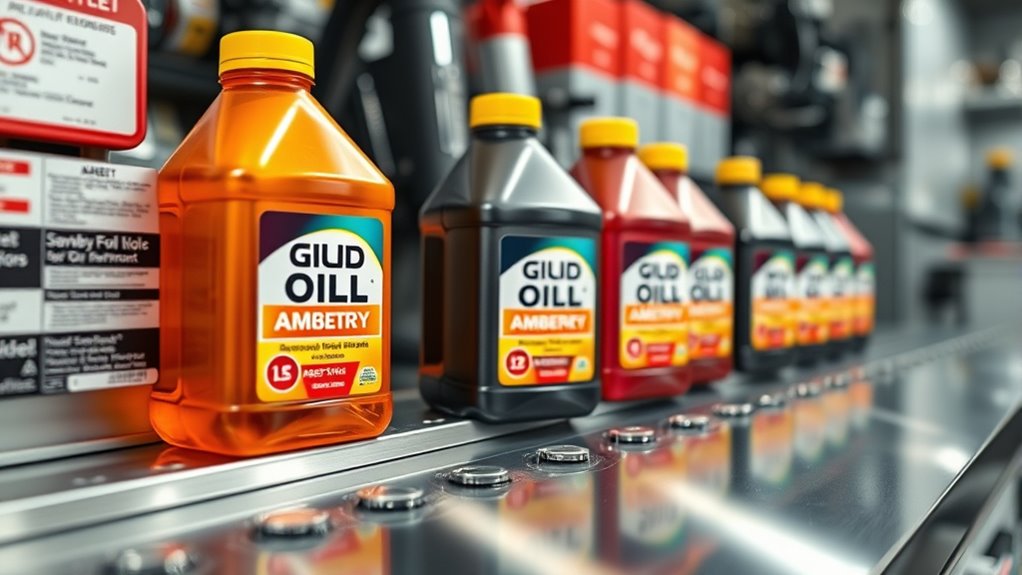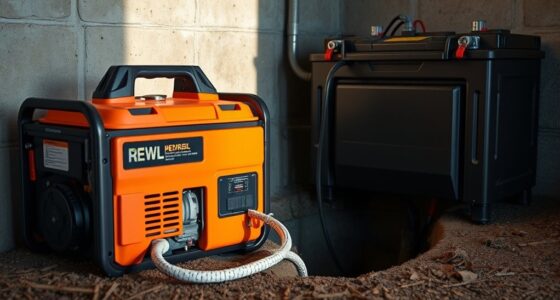To guarantee your standby engine runs safely and reliably, choose the right oil type based on your climate and manufacturer guidelines. Synthetic oils offer better protection and longer intervals between changes, especially in extreme temperatures, while conventional oils are more affordable for light use. Regular oil changes and proper handling are vital to prevent engine damage. Keep an eye on viscosity and maintenance schedules—continue exploring to learn more about keeping your engine in top shape.
Key Takeaways
- Use synthetic or high-mileage oils for better stability and protection during standby periods.
- Always select oil viscosity recommended by the engine manufacturer, especially for temperature extremes.
- Regularly check and change oil at recommended intervals to prevent degradation and engine damage.
- Store and dispose of standby engine oils properly to avoid environmental and safety hazards.
- Conduct routine inspections and maintenance to ensure oil quality and engine readiness for emergency use.
Understanding Different Oil Options and Their Benefits
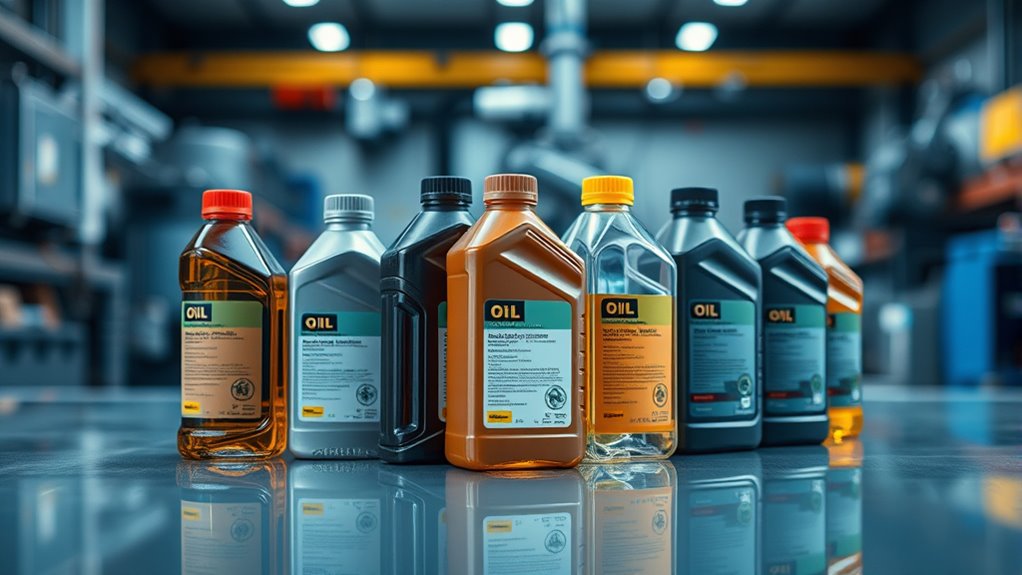
Choosing the right oil for your standby generator is crucial to guarantee reliable performance and longevity. You have several options, including conventional, synthetic, synthetic blend, and high-mileage oils. Conventional oil is affordable and suitable for light or infrequent use, but it requires more frequent changes. Synthetic oil offers superior protection, better stability at extreme temperatures, and longer intervals between oil changes, making it ideal for demanding conditions. Synthetic blends strike a balance, providing better protection than conventional oils without the cost of full synthetics. High-mileage oils contain additives that help protect aging engines by reducing leaks and oil burn-off. Always check your generator’s owner’s manual to select the appropriate oil type based on your model, engine, and manufacturer recommendations. Proper oil choice ensures your generator runs smoothly and lasts longer. Understanding different oil options can help you make informed choices for optimal engine health.
Matching Oil Viscosity to Climate Conditions
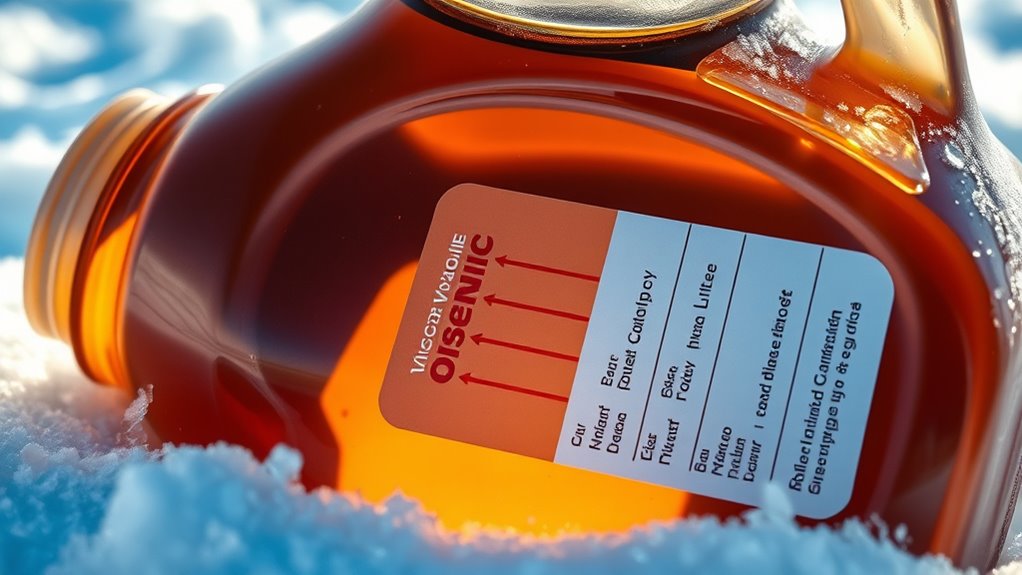
Matching the correct oil viscosity to your climate guarantees your standby generator runs smoothly and stays protected. If you live in a cold climate, choose oils with lower cold-weather numbers like 0W-30 or 5W-30. These oils flow easily during freezing temperatures, ensuring quick starts and proper lubrication. In hot environments, thicker oils such as 10W-30 or 10W-40 help maintain a protective film on engine parts, preventing breakdown under high heat. Synthetic oils offer superior stability across temperature ranges, making them ideal for fluctuating climates. Using the right viscosity reduces startup strain, improves fuel efficiency, and prevents engine wear. Always follow manufacturer recommendations for your region to ensure excellent performance and protection of your standby generator. Supporting Children Through Divorce
Importance of Regular Oil Change Intervals
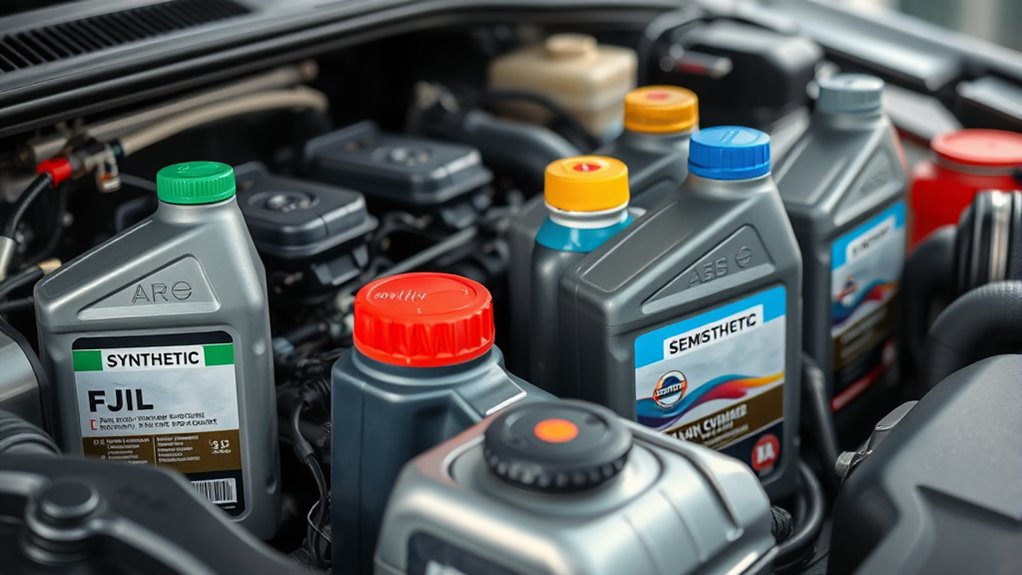
Regular oil changes are essential to prevent engine damage and keep your standby generator running smoothly. Skipping intervals can lead to increased wear, overheating, and costly repairs. By sticking to recommended schedules, you guarantee your engine performs at its best and lasts longer. Manufacturers recommend changing the oil after the first 25 hours of operation to remove debris from the engine break-in process, which is critical for maintaining optimal engine health. Regular maintenance also supports sound engine operation and prolongs the lifespan of your equipment.
Prevents Engine Damage
Regularly changing the oil in your standby engine is essential to prevent damage and keep it running smoothly. Over time, oil degrades, losing its ability to lubricate parts and trap contaminants, which accelerates engine wear and causes overheating. Dirty oil can lead to engine seizure due to poor lubrication, dirt, metal particles, and carbon deposits building up. Using fresh oil reduces friction between engine components, minimizing metal-on-metal contact and wear. When oil becomes overused, it increases engine temperature and risks permanent damage. Clean oil also helps prevent catastrophic failures and extends your engine’s lifespan. Following recommended oil change intervals ensures your engine remains protected from unnecessary harm, keeping it reliable and efficient when you need it most. Additionally, regular oil analysis can help you monitor oil condition and determine the optimal timing for changes. Proper oil selection based on engine type can further enhance engine longevity and performance.
Ensures Optimal Performance
Maintaining proper oil change intervals is crucial for guaranteeing your standby engine performs at its best. Regular oil changes keep the lubricating film intact, reducing friction and preventing wear during startup and operation. They also prevent viscosity breakdown caused by heat and contaminants, which helps maintain steady engine protection. Color accuracy plays a significant role in ensuring that the engine components operate under optimal visual and diagnostic conditions. Following manufacturer-specified schedules supports ideal oil pressure and temperature regulation, improving overall efficiency. Even if your generator is used infrequently, moisture buildup and oil degradation can occur, so annual oil changes are necessary. Using the correct oil grade enhances performance, especially synthetic oils designed for extreme temperatures. Neglecting timely oil changes can lead to sludge buildup, reduced power, and increased risk of engine failure. Staying consistent with oil maintenance ensures your standby engine runs smoothly and reliably whenever you need it. Proper maintenance also helps prevent unexpected breakdowns, saving you time and money on costly repairs.
Recognizing Performance and Protection Features of Oils
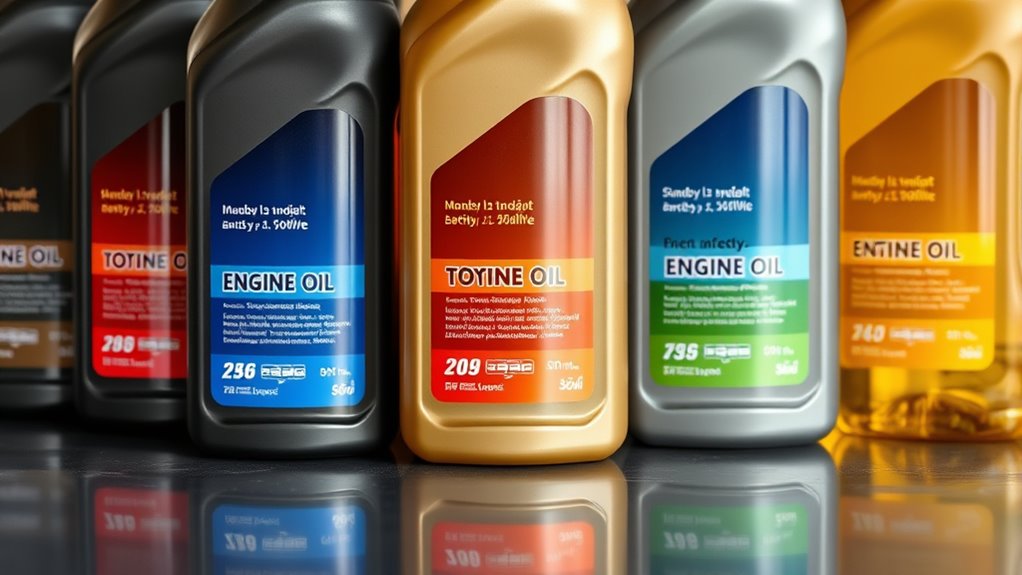
Understanding the key performance and protection features of oils is essential for guaranteeing your standby engine operates reliably and efficiently. Synthetic oils offer superior oxidation resistance, allowing better performance in extreme temperatures and longer oil change intervals. For cold starts, low-viscosity oils like SAE 5W-30 ensure smooth engine starts in low temperatures. Oils with high Total Base Number (TBN) neutralize acids formed during combustion, protecting engine components. Additives help reduce deposits and sludge, keeping the engine clean and well-lubricated. Oils formulated for high ambient and altitude conditions support engine reliability in diverse environments. Recognizing these features helps you select oils that enhance durability, prevent corrosion, minimize wear, and improve overall engine longevity, especially vital for standby engines operating in varying conditions. Additionally, choosing oils that support biodiversity by reducing environmental impact can contribute to more sustainable maintenance practices.
Manufacturer Recommendations for Generac Generators
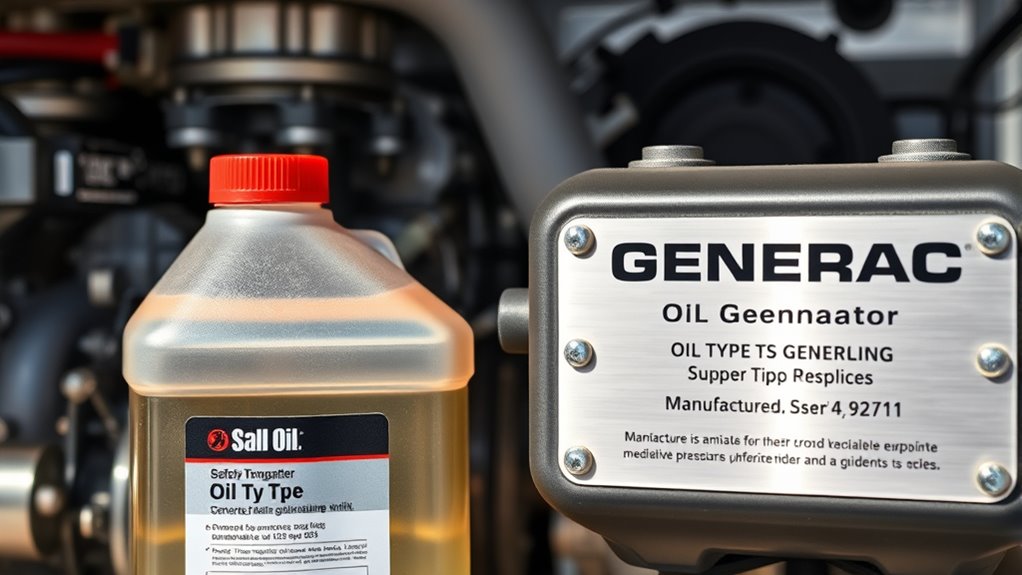
To keep your Generac generator running smoothly, it’s crucial to follow the manufacturer’s oil recommendations. You should use the specified oil types and viscosities for your model and climate conditions to guarantee maximum performance. Ignoring these guidelines can lead to increased wear, reduced efficiency, and potential damage. Using the correct oil not only ensures proper lubrication but also helps maintain the engine’s longevity and efficiency over time. Additionally, staying informed about advancements in automated maintenance technology can aid in optimal engine care.
Recommended Oil Types
Choosing the right oil for your Generac generator is essential for ideal performance and longevity. Start with conventional oil like SAE 10W-30 for the first 20-30 hours to ensure proper engine break-in. After this period, switch to synthetic oils such as SAE 5W-30 or SAE 10W-30, which offer better protection, especially in extreme temperatures. For cold weather below 40°F, synthetic 5W-30 helps with easier starts and lubrication. In very cold climates below 20°F, it’s the best choice. During hot weather above 90°F, SAE 30 or synthetic 10W-30 provides stability. Always choose high-quality detergent oils meeting API SN or newer standards to keep your engine clean and reliable. Using the correct oil type suited to your climate guarantees superior engine performance and durability. Additionally, selecting oils that meet industry standards ensures your generator operates efficiently under varying conditions. Selecting the proper oil type based on climate conditions ensures your generator runs smoothly and lasts longer.
Viscosity Specifications
Selecting the correct oil viscosity according to your generator’s operating temperature is crucial for peak performance and engine longevity. For most Generac models in moderate climates, SAE 10W-30 is recommended. When temperatures drop below 40°F (4°C), switch to SAE 5W-30 synthetic oil to improve cold-start performance and lubrication. In hot conditions above 90°F (32°C), SAE 30 oil can be used, but synthetic SAE 10W-30 generally offers better protection by maintaining viscosity under high heat. SAE 5W-30 synthetic oil is preferred across all temperatures for its stability and engine protection during cold starts and extended operation. Proper viscosity ensures easier startups, reduces engine wear, and maintains lubrication, extending your generator’s lifespan in varying ambient conditions. Additionally, using multi-grade oils helps optimize engine performance across diverse temperature ranges.
Ensuring Safety Through Proper Oil Handling and Disposal
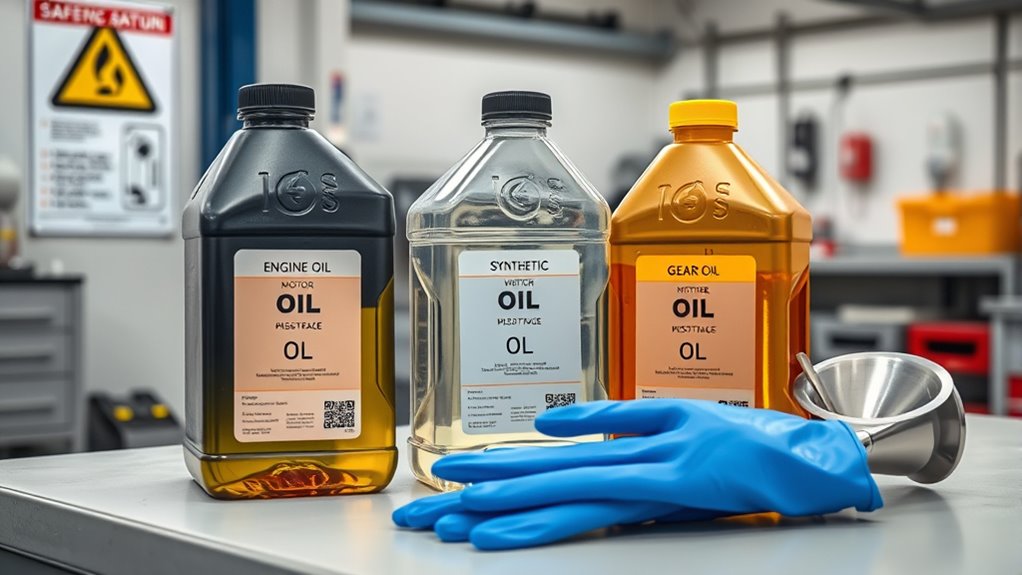
Proper oil handling and disposal are essential for maintaining safety around standby engines. You must store oils in cool, dry, well-ventilated areas away from electrical equipment to prevent fire risks and oil degradation. Keep containers tightly sealed to avoid leaks and contamination, and avoid storing oils near chemicals that could cause reactions. Use designated storage areas for proper inventory control. When handling oils, wear PPE like gloves and eye protection to reduce contact risks. Prevent spills by using correct containers and transfer methods, and dispose of used or contaminated oil immediately following environmental regulations. Proper documentation guarantees compliance. Regular monitoring of stored oils helps detect early signs of degradation or leaks, ensuring safety and performance. Additionally, understanding oil types for standby engines is crucial for selecting the appropriate oils that optimize engine safety and longevity.
Precautions for Cold Weather Oil Usage

When temperatures drop considerably, using the right oil becomes crucial to guarantee your standby engine runs smoothly. Synthetic SAE 5W-30 oil is your best choice below 20°F (-7°C) because it stays thin enough for easy cold starts, reducing engine wear. Avoid thicker oils like 15W-40, as they flow poorly in cold weather and make engine turnover harder. Oils with higher “W” ratings, such as 10W-30, are suitable for moderate climates but not below freezing. Synthetic oils generally outperform conventional ones in cold conditions due to better flow and stability. Always follow your generator manufacturer’s recommendations for cold-weather oil. Regularly check and replace oil before winter, and consider using block heaters or running the engine weekly to ensure proper circulation and prevent moisture buildup. Additionally, understanding penetration testing can help identify vulnerabilities in your engine’s control systems to prevent potential cyber threats.
Maintaining Optimal Oil Levels for Reliable Operation
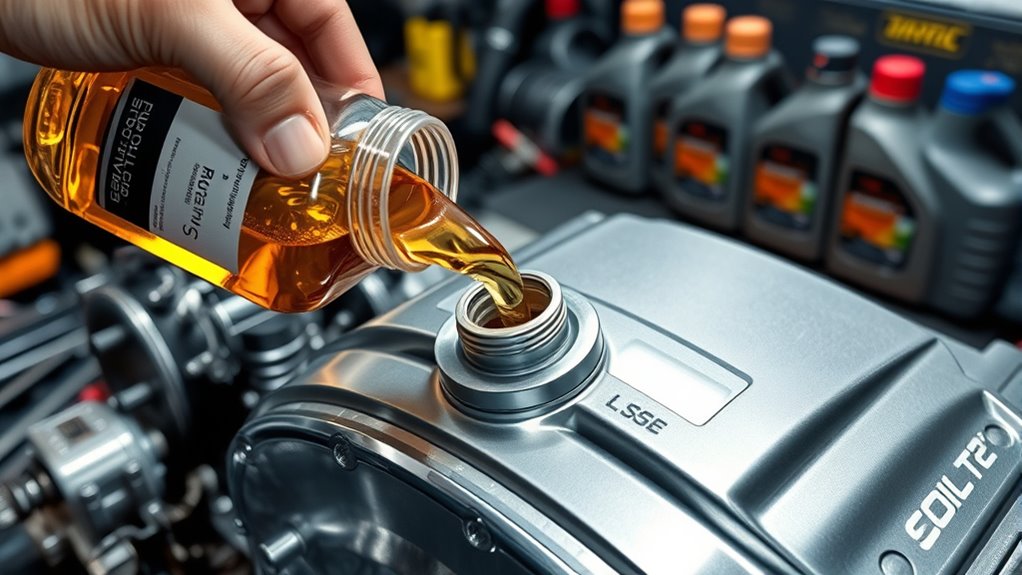
Keeping an eye on your standby engine’s oil level is essential for reliable operation. Check the oil when the engine is off, waiting 10 minutes after shutdown to allow oil to settle. Maintaining the oil close to the “full” mark on the dipstick ensures proper lubrication and reduces wear. Regular inspections help catch leaks or oil depletion early. Use recommended oils, such as synthetic or diesel-grade, for peak performance. Remember, consistent monitoring prevents engine damage and extends lifespan. Here’s a quick reference:
| Step | Action | Frequency |
|---|---|---|
| Check oil level | Off, 10-minute wait | Weekly or during maintenance |
| Top off oil | When below recommended level | As needed |
| Change oil and filter | Every 100-200 hours or annually | Per manufacturer guidelines |
| Use recommended oil types | Match owner’s manual specifications | During every oil change |
| Inspect for leaks | Visual check during inspections | Weekly or regularly |
Additionally, understanding the importance of oil quality helps ensure the engine runs smoothly and reduces the risk of failure.
Frequently Asked Questions
Can I Mix Synthetic and Conventional Oils in My Generator?
Yes, you can mix synthetic and conventional oils in your generator if needed, especially in emergencies or short-term situations. Just keep in mind that mixing dilutes the benefits of synthetic oil, which can reduce engine protection and longevity over time. Ideally, you should fully switch to one type and follow your manufacturer’s recommendations for oil changes to guarantee ideal performance and engine health.
How Do I Know if My Oil Needs Changing Before Scheduled Intervals?
Did you know that degraded oil can cause engine wear up to 50% faster? You’ll know your oil needs changing if the dashboard shows an oil warning light or if the oil appears dark, gritty, or sticky on the dipstick. Also, listen for unusual engine noises or notice increased engine temperature. Regular visual checks and monitoring dashboard alerts help catch oil issues early, preventing costly engine damage.
Are There Specific Oil Brands Recommended for Standby Engines?
You should choose reputable brands like Mobil 1, Briggs and Stratton, Royal Purple, Honda, or Amsoil for your standby engine. These brands are well-rated for small engine protection, durability, and performance. Opt for oils that match your climate and engine specifications, such as 5W-30 or 10W-30 synthetic. Using trusted brands guarantees your engine stays reliable during long periods of inactivity and handles sudden load demands effectively.
What Are the Risks of Using Incorrect Oil Viscosity in Cold Climates?
Think of your engine as a delicate dancer waiting for the perfect tune. Using the wrong oil viscosity in cold climates is like forcing the dancer into heavy shoes or flimsy slippers. Thick oil delays startup, increasing wear, while thin oil fails to protect once warmed. Both scenarios cause friction, overheating, and damage, risking premature engine failure. You need the right viscosity to keep your engine performing gracefully in cold weather.
How Should I Store Unused Oil to Ensure Safety and Quality?
You should store unused oil in a cool, dry, and well-ventilated area to maintain its quality and safety. Keep containers tightly sealed and labeled properly, avoiding exposure to moisture, temperature fluctuations, and contaminants. Use original containers and handle with clean tools to prevent contamination. Elevate containers off the ground and inspect regularly for damage. Store away from chemicals and electrical equipment to reduce fire risk and make sure of safe, effective storage.
Conclusion
Choosing the right oil isn’t just about following rules—it’s about trusting that proper maintenance fuels your generator’s safety and longevity. Think of oil as the lifeblood of your standby engine; neglecting it can lead to failure when you need backup most. By understanding oil types, changing them on schedule, and handling them responsibly, you’re not only protecting your equipment but also proving that proactive care truly makes all the difference in safeguarding your home and loved ones.

